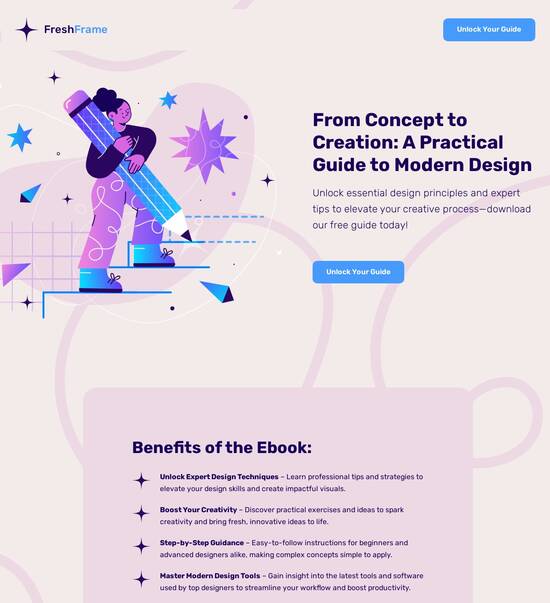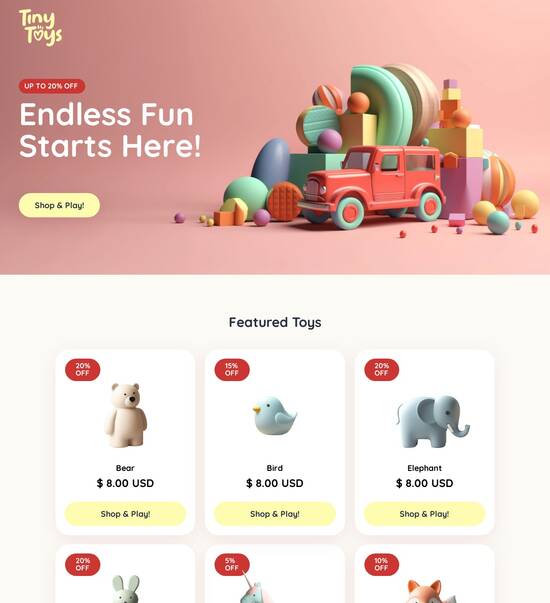
HTML page template for disaster relief organizations
Use TemplateAbout template
Engage your audience like never before with stunning landing page templates for disaster relief organizations. Make your online presence unforgettable!
Recommended templates

Easy to build without coding
With the intuitive drag-and-drop builder, anyone on your team can create high-converting pages without any knowledge of code or design. Make enhancements to your landing page with custom widgets using Javascript, HTML/CSS, or third-party scripts.

Multiple layouts for any industry and goal
Select from 500+ landing page layouts built to boost conversions across industry-specific scenarios. Customize them by adjusting fonts, adding images, and generating on-brand content with the AI assistant. Quickly scale with Instablocks® and Global Blocks that you can save, reuse, and update globally.

Loads fast and looks polished on any device
Every template is responsive, which means they present professionally on any device and load blazingly fast with our Thor Render Engine. You can also power them up with Google AMP technology to deliver an unparalleled mobile experience and drive higher conversions.

Robust analytics & experimentation
Get real-time updates and reporting across all your devices, showing the number of visitors, conversions, cost-per-visitor, and cost-per-lead. Launch AI-powered experiments, run A/B tests, and use heatmaps to analyze user behavior, then optimize your landing page to maximize conversions.







Easy to build without coding
With the intuitive drag-and-drop builder, anyone on your team can create high-converting pages without any knowledge of code or design. Make enhancements to your landing page with custom widgets using Javascript, HTML/CSS, or third-party scripts.
Multiple layouts for any industry and goal
Select from 500+ landing page layouts built to boost conversions across industry-specific scenarios. Customize them by adjusting fonts, adding images, and generating on-brand content with the AI assistant. Quickly scale with Instablocks® and Global Blocks that you can save, reuse, and update globally.
Loads fast and looks polished on any device
Every template is responsive, which means they present professionally on any device and load blazingly fast with our Thor Render Engine.
Robust analytics & experimentation
Get real-time updates and reporting across all your devices, showing the number of visitors, conversions, cost-per-visitor, and cost-per-lead. Launch AI-powered experiments, run A/B tests, and use heatmaps to analyze user behavior, then optimize your landing page to maximize conversions.
All the features you need to build lead-generating landing pages
Explore more featuresLearn how to build top-performing landing pages for any goal
FAQs
Leading the way in building high-performing landing pages





Elevate Your Campaigns with Instapage Landing Pages
In today's competitive landscape, having an effective landing page is crucial for any marketing campaign. Instapage's landing page and conversion rate optimization (CRO) platform provides marketers with the essential tools to create high-impact campaigns that maximize return on investment (ROI) and streamline lead generation efforts. With over 100 high-converting templates and lead-gen elements, this platform enables swift page creation tailored to diverse audience needs within the USA.
Understanding Instapage Features
Instapage distinguishes itself with a suite of powerful features designed to enhance user experience and drive conversions. Here are the key aspects:
- Customizable Templates: Choose from 100+ flexible landing page templates that are easily customizable to reflect your brand identity.
- Built-in A/B Testing: Optimize your pages effectively by conducting A/B tests to determine which designs and content yield the best results.
- Analytics Dashboard: Leverage comprehensive analytics to assess user behavior, page performance, and conversion metrics in real time.
Step 1: Design Your Landing Page
Let’s dive into creating your landing page with Instapage. Start by selecting a template that aligns with your promotion goals. Here’s how:
Step 2: Optimize for Conversions
After selecting your template, the next step involves optimizing it for conversions. Use the following strategies:
- Implement Dynamic Text Replacement: Tailor the messaging based on the traffic source to enhance relevance.
- Incorporate Instablocks for Quick Editing: These reusable elements can maintain consistency and speed up the design process.
- Utilize Heatmaps: Analyze where users click to fine-tune your layout for better engagement.
Step 3: Publish and Promote
Once your landing page is designed and optimized, it’s time to go live. Consider the following for effective promotion:
- Integrate with Your Marketing Channels: Share your new landing page across all digital marketing channels, including social media and email.
- Set Up Tracking Pixels: Use Facebook or Google tracking to monitor return on ad spend (ROAS) from your campaigns.
- Create Compelling CTAs: Ensure your calls-to-action are enticing enough to drive users to your desired outcome.
By following these steps, you can efficiently create a landing page that not only captivates your audience but also drives conversions.
Ready to supercharge your digital marketing efforts? Start with Instapage today and unlock the potential of high-converting landing pages tailored for your audience.
HTML page template for disaster relief organizations
Understanding the heart of disaster relief organizations
Disaster relief organizations play a crucial role in managing emergencies, offering immediate assistance to communities affected by crises such as natural disasters, epidemics, or humanitarian conflicts. These organizations often include NGOs, government agencies, and local community groups that collaborate to deliver services. Their operations range from providing food and medical assistance to rebuilding infrastructure and supporting emotional recovery. The nature of their work emphasizes the importance of a rapid response and foster community support to alleviate suffering and restore normalcy as quickly as possible.
In recent years, the rise of digital platforms has transformed how disaster relief organizations operate. An effective online presence has become essential, particularly for fundraising efforts and volunteer recruitment. Organizations are increasingly recognizing the need for an engaging website that communicates their mission, showcases their work, and encourages community participation. Hence, having an HTML page template that is tailored to the unique needs of disaster relief will significantly enhance outreach and provide a streamlined mechanism for gathering support.
Core elements of HTML page templates
An HTML page template serves as a foundational layout, enabling organizations to build a website quickly and efficiently without starting from scratch. Typically, it includes layout structures, placeholders for content, design styles, and functionalities tailored to a specific purpose. Key structural components of these templates may encompass headers, footers, navigation bars, image placeholders, and call-to-action buttons that guide users toward desired actions.
Utilizing HTML templates offers several advantages to disaster relief organizations. Firstly, they simplify the website creation process, allowing organizations to allocate resources elsewhere. Secondly, consistent design and functionality across different web pages increase user trust and make navigation easier. Lastly, even organizations with limited technical expertise can launch functional websites based on templates, allowing them to remain focused on their primary mission.
Designing for impact: The aesthetic and functional balance
Visual design plays a pivotal role in how disaster relief organizations communicate their message. An approachable and empathic design can enhance the emotional connection with users, leading to greater engagement. The selection of color schemes should reflect urgency and compassion, with a focus on colors such as blue, green, and orange, which are often associated with trust, hope, and action. Typography also matters; legible fonts should be prioritized to ensure that messages are easily understood, especially in times of crisis.
Furthermore, optimizing user experience (UX) is essential. A website that features intuitive navigation allows visitors to find information quickly, whether they are looking to volunteer, donate, or learn about ongoing efforts. As mobile usage continues to dominate, responsive designs are not just beneficial but necessary. Users should have a consistent experience across various devices, ensuring that the critical information needed in times of emergency is always accessible.
Essential sections in disaster relief organization templates
When designing an HTML template for disaster relief organizations, certain sections are vital to ensure the website meets its functional and outreach objectives. The hero section, often the first thing visitors see, should include impactful images or videos alongside strong messaging and clear calls to action, like 'Donate Now' or 'Join Us.' This immediate engagement is crucial for motivating visitors towards meaningful action.
Another essential area is the 'About Us' section, which should concisely convey the organization’s mission, history, and credibility. This builds trust with visitors who may not be familiar with the organization. Visual storytelling is powerful, so including a gallery feature that highlights past efforts through compelling visuals enhances emotional connection and understanding. Additionally, integrating tools that help with volunteer management is essential; showing available opportunities and providing easy sign-up forms ensures seamless participation from community members.
Hero Section: Impactful images, strong messaging, calls to action.
About Us Section: Clear mission statements and organization history.
Gallery Feature: Visual storytelling that highlights past relief efforts.
Volunteer Management Tools: Streamlined sign-up processes for volunteers.
Donor Recognition: Showcasing donor appreciation and transparency.
Tailoring templates for specific needs
The flexibility of HTML templates allows disaster relief organizations to tailor designs based on specific operational needs. For organizations focused on providing immediate assistance in the aftermath of a disaster, templates should include features for rapid updates and real-time information sharing. This capability enables organizations to inform the public about current needs, such as supplies or volunteer support and essential information like safety guidelines.
On the other hand, long-term recovery templates might focus on showcasing ongoing needs and future goals. This could involve integrating fundraising features that provide transparency on how donations are utilized. Moreover, the scope of operations, whether local or international, determines the kind of content and design adjustments needed. For local organizations, hyper-local features such as local volunteering opportunities can be emphasized, while international organizations might highlight global cooperation and diverse needs.
Harnessing the power of AI in template design
Incorporating AI into HTML template design can dramatically enhance the effectiveness of a disaster relief organization’s website. Machine learning algorithms can help personalize user experiences, analyzing visitor behavior to optimize content placement and engagement strategies. For example, AI can adjust messaging in real time based on user interactions and preferences, ensuring that the displayed content is relevant and compelling.
Additionally, content generation tools streamline communication efforts. Using AI, disaster relief organizations can automate updates and engagement through chatbots or virtual assistants, making it easier for visitors to find information and get responses to their queries. These AI-driven tools enhance visitor engagement and create a more efficient channel for providing timely support and information, which is critical during emergencies.
Enhancing engagement with multiple features
An effective HTML template for disaster relief organizations should integrate several features to maximize community engagement. Adding social media feeds directly onto the site ensures that visitors can stay updated with real-time information about ongoing initiatives, share posts, and foster a sense of community engagement. Highlighting community stories and testimonials can also enhance connection and trust.
Newsletter sign-up options are crucial to maintaining contact with supporters. Simple, accessible forms can help organizations gather email contacts, allowing for regular updates and informative campaigns that keep supporters engaged. Additionally, event calendars play a pivotal role in promoting upcoming initiatives, volunteer opportunities, and fundraising events, ensuring visibility and participation.
Integration of Social Media Feeds: Real-time updates and community connection.
Newsletter Signup: Easy forms to gather supporter emails.
Event Calendars: Promotion of upcoming initiatives and fundraising efforts.
Process of implementing HTML page templates
Implementing HTML page templates effectively requires careful planning and consideration. It's essential to choose the right template based on the organization's size, target audience, and mission. Features included in the template should align with organizational goals, and flexibility should be built into the design for future adjustments. Organizations also need to assess customization options, ensuring that implementation offers a unique online presence that stands out.
Another critical factor is establishing workflows for content management. Regularly updating website content can keep the audience informed and engaged. Setting up a routine for content updates is vital to maintaining relevance and ensuring that information is accurate, especially in an environment that can change rapidly, such as during emergencies. Testing site functionality and optimizing for user engagement should be an ongoing effort. Utilizing analytics tools can provide insights into what content resonates with visitors, guiding future modifications.
Real-world examples and case studies
Real-life applications of HTML templates demonstrate their effectiveness in tangible ways. Many disaster relief organizations have successfully utilized templates to revamp their online presence, significantly increasing their ability to gather donations and volunteers. By examining these real-world success stories, organizations can gain insights into effective strategies adopted by their peers.
However, it is also essential to consider lessons learned from these implementations. Common challenges, such as maintaining website updates or engaging the audience, should inform best practices. By studying successful organizations, disaster relief groups can extract actionable strategies and avoid potential pitfalls, paving the way for their future successes.
The future of web presence in disaster relief
As technology evolves, so too do the web design needs of disaster relief organizations. Emerging trends indicate that the digital landscape will continue to shift, driven by advancements in design and technology. Responsive and flexible designs will remain integral, ensuring that organizations can adapt to the changing communication needs of their audiences while maximizing impact.
Websites play an increasingly pivotal role in disaster management, serving as platforms for both immediate response and community rebuilding initiatives. As templates adapt to serve diverse populations and circumstances, they will continue to be instrumental in not only responding to crises but fostering community resilience and preparation for future emergencies.
Summarizing the viability of HTML templates for disaster relief
HTML page templates provide disaster relief organizations with the tools they need to establish a strong online presence. Given the unique challenges these organizations face, flexibility and innovation in web design remain paramount. Implementing designs that prioritize user experience and facilitate engagement will significantly boost support for their missions.
Encouraging organizations to embrace these digital solutions is essential; the impact of an effective website can extend far beyond mere aesthetics. Well-designed landing pages enhance communication, attract donations, and maximize volunteer sign-ups, thereby driving the mission of disaster relief initiatives further into the community.
Ready to skyrocket conversions?
Supercharge your ad campaigns with high-performing landing pages
Get started














